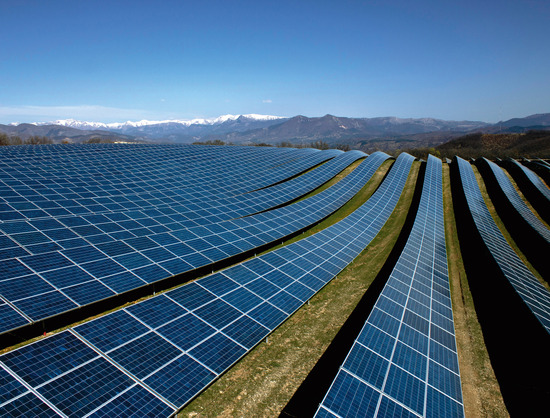Qatar Doubles Solar Power with New 875 MW Plants
Doha, Qatar
Qatar has taken a giant leap forward in its clean energy journey by officially switching on two massive solar power plants, Ras Laffan and Mesaieed, with a combined capacity of 875 megawatts (MW). This major milestone more than doubles the country’s installed solar capacity, raising it from 800 MW to an impressive 1,675 MW. It marks a bold step toward Qatar’s goal of becoming a leader in renewable energy in the Gulf region.
A Bold Move Toward Renewable Energy
The Ras Laffan and Mesaieed photovoltaic (PV) power plants are located in the country’s northeast, near Qatar’s key industrial hub. Both plants are equipped with advanced solar technology, including over 1.6 million DeepBlue 3.0 solar modules supplied by China-based JA Solar. The construction was carried out in partnership with South Korea’s Samsung C&T.
The commissioning of these plants is a landmark achievement for QatarEnergy, the state-owned energy giant, and for the country’s broader energy strategy. Until now, Qatar has been best known for its vast reserves of oil and natural gas. But as global pressure mounts to reduce carbon emissions and tackle climate change, Qatar is increasingly investing in renewable energy to balance its fossil fuel-heavy portfolio.
National Expertise in Action
One of the most remarkable aspects of these projects is the heavy reliance on national expertise. At the inauguration ceremony, Saad Sherida Al-Kaabi, Qatar’s Minister of State for Energy Affairs and the President and CEO of QatarEnergy, emphasized the shift away from dependency on foreign contractors.

“We are proud that Qatar now has the knowledge and skills to deliver these large-scale solar projects on our own,” said Al-Kaabi. “This reflects our commitment to building national capabilities and advancing renewable energy development within the country.”
This approach is seen as a boost not only for the energy sector but also for Qatar’s job market, as local engineers, technicians, and project managers play a bigger role in shaping the country’s energy future.
Environmental and Economic Impact
The environmental benefits of the Ras Laffan and Mesaieed plants are significant. Together, they are expected to reduce carbon dioxide emissions by more than 1 million tons per year — the equivalent of taking about 200,000 cars off the road annually. This directly supports Qatar’s pledge to cut its greenhouse gas emissions and move toward a low-carbon economy.
On the economic side, expanding renewable energy capacity will also help Qatar free up more of its natural gas for export rather than domestic use, potentially boosting state revenues. By diversifying its energy mix, Qatar strengthens its resilience against global energy market fluctuations and demonstrates its commitment to long-term sustainability.
Looking to the Future
Qatar’s ambitions in solar energy don’t stop here. In September 2024, QatarEnergy announced plans for a massive 2-gigawatt (GW) solar power plant in Dukhan, located in western Qatar. Once completed in 2029, this plant will dwarf the combined capacity of Ras Laffan and Mesaieed and further solidify Qatar’s reputation as a regional clean energy leader.
The Dukhan project will include cutting-edge technologies such as battery storage systems to ensure a stable supply of electricity even during cloudy days or after sunset. This reflects a global trend where countries are not only adding renewable capacity but also improving the reliability of their clean energy grids.
International Partnerships and Regional Leadership
Qatar’s push into solar energy comes at a time when the Gulf region is increasingly focused on renewable development. Neighboring countries like Saudi Arabia and the United Arab Emirates have also launched major solar and wind projects in an effort to diversify their energy sources.
By accelerating its renewable projects, Qatar is positioning itself as a key player in the Middle East’s green energy race. International collaborations, such as the partnership with JA Solar and Samsung C&T, have helped fast-track progress, while the government’s focus on national expertise signals a clear intention to lead from within.
Challenges and Opportunities Ahead
Despite this progress, Qatar still faces challenges. Solar energy accounts for just a fraction of the country’s overall power generation, which remains dominated by natural gas. Integrating large-scale solar power into the national grid requires significant upgrades in infrastructure, smart grid technology, and energy storage solutions.
However, experts point out that the falling costs of solar technology, combined with Qatar’s abundant sunlight, make solar power one of the most promising paths forward for the country. There is also a growing awareness among the Qatari population about climate change and the need for sustainable energy solutions, providing social support for these projects.
Conclusion
The launch of the Ras Laffan and Mesaieed solar power plants is more than just a technical achievement — it’s a powerful statement about Qatar’s future. It shows that the country is serious about reducing its carbon footprint, investing in renewable energy, and building a more sustainable economy.
With further mega-projects like the Dukhan solar plant on the horizon, Qatar is not just following the global energy transition — it is aiming to help lead it. As Al-Kaabi put it during the launch event, “This is just the beginning. Qatar’s energy story is being rewritten, and the next chapters will be powered by the sun.”
For more information click here



